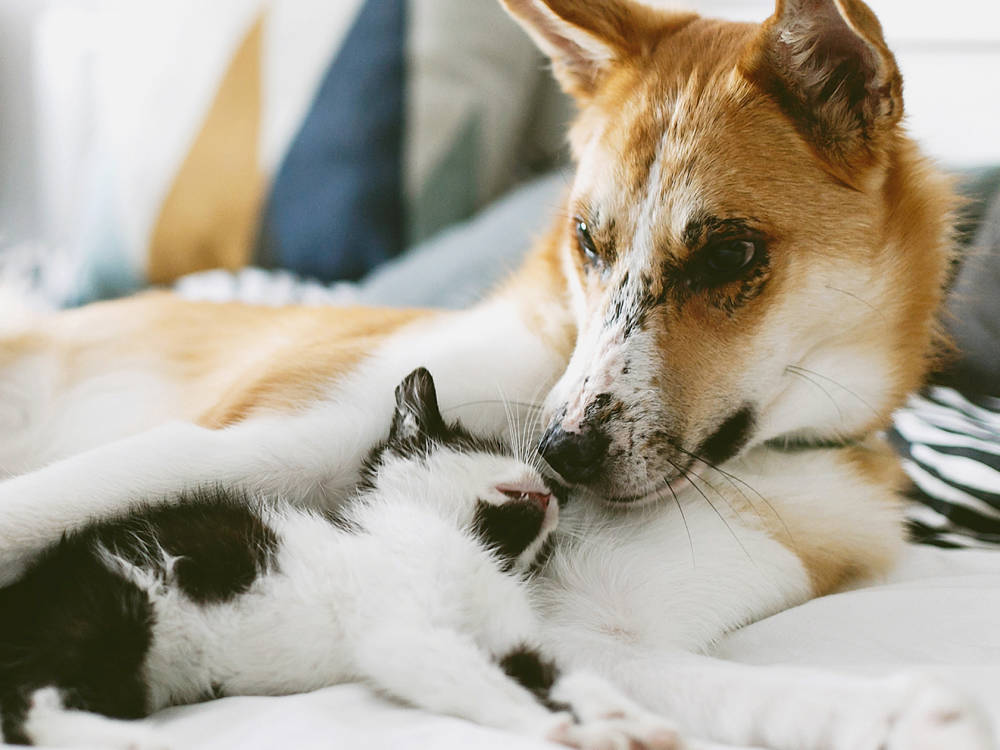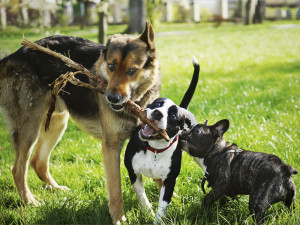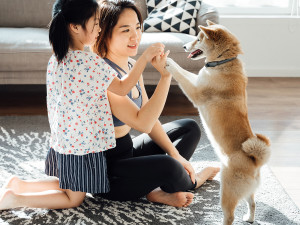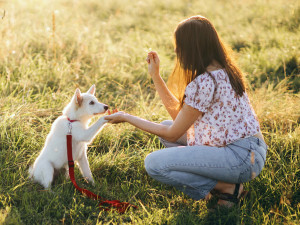Animal House: How to Intro a New Dog to Your Other Pets
...Without turning your home into a circus.

Share Article
If you spend any time on YouTube, you know that dogs are best friends with each other, they love to snuggle with cats, and a parrot walking on their head is their idea of a good time. It’s all very magical and happy. Except it’s not true — at least, it’s not true of every dog, every time.
Sometimes a new dog will hit it off with your other pets right away; other times, one or both parties need a little (or a lot) of convincing. Ultimately, you can’t control the type of relationship your pets will have with each other. But like any good matchmaker, you can increase the chance of success with a carefully orchestrated introduction. When you bring your new dog home, try these strategies to get everyone off to a good start.

littleKin™ is Kinship’s home just for puppy and kitten parents. Bop over to check out expert advice, new pet tools, and special deals—all curated for your newest family member.
opens in a new tabPay attention to body language
When you introduce your new pup to your other dog (or another pet), you’re going to need some sense of how the meeting is going. Unfortunately, dogs can’t talk. But, they can tell you a lot with their body language — you just need to know what to look for. “Understanding body language is going to give you key information about how your dog is feeling in any given moment, and that will impact the choices you make,” says Dr. Susannah Teran. “If you can tell that your dog is relaxed and happy, great! The introduction can continue. But if you see signs of fear or aggression,opens in a new tab you’ll want to intervene before the situation escalates.”
Start in neutral territory
The last thing you want when introducing dogs is an instant turf war. Rather than bringing your new dog directly into your home — where your other dog may feel territorial — let them meet in a neutral location. With the help of a friend or family member, walk the dogs on leashes in a nearby park or neighborhood. They may be hesitant to interact at first, and that’s okay. As they get more comfortable, they’ll start to engage. Let them check each other out for a few seconds, then pull them apart and give them a little space. As long as they are both showing positive body language, you can let them engage for longer periods and then bring them home.
Take it slow with cats and other small animals
Curious how to introduce a dog to a cat? Start by having them in separate rooms. Let them get used to each other’s smell, then allow them to see each other through a baby gate or screen. When they’re ready to meet face-to-face, have your dog on a leash, and make sure your cat can get away if they want to. Valerie Peck, a certified dog trainer, has this pro tip: “You don’t want them to meet if your dog is on high alert or overly interested in the cat. If your dog is whining or scratching at the door trying to get to the cat, wait until their excitement level has lowered before doing the introduction.” A similar approach works for other small pets. Let your pup get used to the smells and sounds of the other animal before you start face-to-face introductions — always with your dog on a leash.
Be careful with food, toys, and other resources
To help avoid conflicts, make sure all pets have their own food dishes, water bowls, and beds. Initially, feed them in separate rooms and don’t leave toys or any of their favorite items lying around. “I recommend being cautious with things like food and chews for the first three months,” says Peck. “It takes about that long for a new dog to feel comfortable in a home. And if they’re not fully settled, their tendency to guard their stuff might be higher.”
Make sure everyone has their own safe space
All pets need to have a place they can go to feel safe or have some downtime. You can use baby gates or a crate to give your new pup a spot to decompress (and give your other dog a break from their new roommate). And cats should always have an area where they can escape to.
Monitor interactions
As your dog is getting to know your other pets, and vice versa, you’ll want to keep an eye on their interactions. Praise them when they’re behaving appropriately, and intervene if you notice any growling or aggressive body language. To diffuse the situation, redirect your dog’s attention and then separate your pets for a bit. For the first three weeks, Peck advises against leaving your pets alone together. “When they’re around each other, make sure you’re actively watching them. And don’t leave them alone in the house together until you know they are really comfortable with each other.”
Be patient
When it comes to successfully integrating a new dog into your home, patience is a virtue. “The biggest mistake that I see pet parents make is trying to rush the process,” says Dr. Teran. “Helping pets learn to live together peacefully is a process. Sometimes it goes relatively quickly, and other times it takes longer. But don’t skip steps. Your patience will pay off in the long run.”

Kate Sheofsky
Kate Sheofsky hails from San Francisco, where she developed a love of writing, Giants baseball, and houses she can’t afford. She currently lives in Portland, OR, and works as a freelance writer and content strategist. When not typing away on her laptop, she enjoys tooling around the city with her two rescue pups searching for tasty food and sunny patios.
Related articles
![mom and daughter playing with puppy]() opens in a new tab
opens in a new tabHow to Introduce Your New Dog to Your Kids
They’ll always remember their first childhood pet—this intro is just the beginning.
![Happy young female student playing with hairy dog at home]() opens in a new tab
opens in a new tabYou’ve Got Company: How to Cohabitate with a New Dog
Boundaries, right? But if they end up sleeping in bed, that’s cool, too.
![Scared tan dog against brick wall background]() opens in a new tab
opens in a new tabDoes Your Dog’s Growl Mean Aggression?
Remember, dogs have more than one emotion.
- opens in a new tab
Can Dogs Communicate With Each Other?
It’s about more than barking.
![dogs at dog park drinking water and playing in pool]() opens in a new tab
opens in a new tabDog Park Etiquette: Dog Park Dos and Don’ts
New kid on the block? Follow this trainer’s tips before letting your pet run wild.
![Woman training cute white puppy to behave and new tricks in summer meadow.]() opens in a new tab
opens in a new tabWhy You Shouldn’t Be Skeptical of Positive Training Methods
It is powerful enough, even for the tough cases, and it is the best choice—here’s why.






